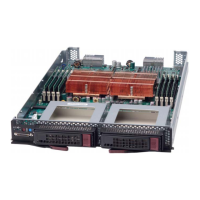6-7
Chapter 6: BIOS
Super IO Configuration
The menu options in the SUPER IO CONFIGURATION submenu and their descriptions are
shown in Table 6-5.
Chipset Configuration
The CHIPSET CONFIGURATION submenu contains two submenus as shown in Table 6-6.
NorthBridge Configuration
The menu options in the NORTHBRIDGE CONFIGURATION submenu and their descriptions
are shown in Table 6-7.
Table 6-5. Super IO Configuration Submenu
Menu Option Description
Serial Port1 Address
This option specifies the base I/O port address and Interrupt Request address of
serial port 1. The options are D
ISABLED, 3F8/IRQ4, 3E8/IRQ4 and 2E8/IRQ3.
• Select D
ISABLED to prevent the serial port from accessing any system
resources. When this option is set to D
ISABLED, the serial port physically
becomes unavailable.
• Select 3F8/IRQ4 to allow the serial port to use 3F8 as its I/O port address
and IRQ 4 for the interrupt address.
Serial Port2 Address
This option specifies the base I/O port address and Interrupt Request address of
serial port 2. The options are D
ISABLED, 2F8/IRQ3, 3E8/IRQ4 and 2E8/IRQ3.
Select D
ISABLED to prevent the serial port from accessing any system resources.
When this option is set to D
ISABLED, the serial port physically becomes
unavailable.
Select 2F8/IRQ3 to allow the serial port to use 2F8 as its I/O port address and
IRQ 3 for the interrupt address.
Serial Port 2 Mode
This tells the BIOS which mode to select for serial port 2. The options are
Normal, I
RDA and ASKIR.
Table 6-6. Chipset Configuration Submenu
Menu Option Description
X NorthBridge
Configuration
This menu option configures the NorthBridge Chip. For details see Table 6-7.
X SouthBridge/
MCP55 Configuration
This menu option configures the SouthBridge/MCP55 Chip. For details see
Table 6-8.
Table 6-7. NorthBridge Configuration Submenu
Menu Option Description
X Memory Configuration
Bank Interleaving
Select Auto to automatically enable interleaving-memory scheme when this
function is supported by the processor. The options are Auto and Disabled.

